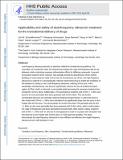Applicability and safety of dual-frequency ultrasonic treatment for the transdermal delivery of drugs
Author(s)
Schoellhammer, Carl Magnus; Srinivasan, Sharanya; Barman, Ross; Mo, Stacy H.; Langer, Robert S; Polat, Baris E.; Blankschtein, Daniel; ... Show more Show less
DownloadApplicability and safety of dual.pdf (2.062Mb)
PUBLISHER_CC
Publisher with Creative Commons License
Creative Commons Attribution
Terms of use
Metadata
Show full item recordAbstract
Low-frequency ultrasound presents an attractive method for transdermal drug delivery. The controlled, yet non-specific nature of enhancement broadens the range of therapeutics that can be delivered, while minimizing necessary reformulation efforts for differing compounds. Long and inconsistent treatment times, however, have partially limited the attractiveness of this method. Building on recent advances made in this area, the simultaneous use of low- and high-frequency ultrasound is explored in a physiologically relevant experimental setup to enable the translation of this treatment to testing in vivo. Dual-frequency ultrasound, utilizing 20 kHz and 1 MHz wavelengths simultaneously, was found to significantly enhance the size of localized transport regions (LTRs) in both in vitro and in vivo models while decreasing the necessary treatment time compared to 20 kHz alone. Additionally, LTRs generated by treatment with 20 kHz + 1 MHz were found to be more permeable than those generated with 20 kHz alone. This was further corroborated with pore-size estimates utilizing hindered-transport theory, in which the pores in skin treated with 20 kHz + 1 MHz were calculated to be significantly larger than the pores in skin treated with 20 kHz alone. This demonstrates for the first time that LTRs generated with 20 kHz + 1 MHz are also more permeable than those generated with 20 kHz alone, which could broaden the range of therapeutics and doses administered transdermally. With regard to safety, treatment with 20 kHz + 1 MHz both in vitro and in vivo appeared to result in no greater skin disruption than that observed in skin treated with 20 kHz alone, an FDA-approved modality. This study demonstrates that dual-frequency ultrasound is more efficient and effective than single-frequency ultrasound and is well-tolerated in vivo.
Date issued
2015-02Department
Massachusetts Institute of Technology. Department of Biology; Massachusetts Institute of Technology. Department of Chemical Engineering; Massachusetts Institute of Technology. Department of Mechanical Engineering; Koch Institute for Integrative Cancer Research at MITJournal
Journal of Controlled Release
Publisher
Elsevier
Citation
Schoellhammer, Carl M. et al. “Applicability and Safety of Dual-Frequency Ultrasonic Treatment for the Transdermal Delivery of Drugs.” Journal of Controlled Release 202 (2015): 93–100.
Version: Author's final manuscript
ISSN
0168-3659